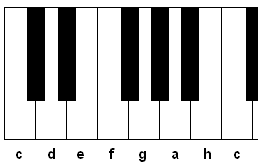Scale (music)
set of musical notes ordered by pitch From Wikipedia, the free encyclopedia
In music, a scale is a set of notes in order of their pitch (that is, their frequency).[1] If the scale starts with the note which has the lowest pitch and goes up to the note with the highest pitch, the scale is called ascending.[2] If the scale starts with the note which has the highest pitch and goes down to the note with the lowest pitch, the scale is called descending.[3] Scales are often the same both ascending and descending, but this is not always true. Very often, a scale is defined over an interval (such as an octave). The most common scales use intervals of five, six or seven different notes.


 C major scale (help·info)
C major scale (help·info)Major and minor scales
Major scales
On a piano, there are white keys and black keys. If we start on the note C and play each white key going up until we come to the next C, we have played the C Major scale. It has eight notes because there are eight notes from each C to the next one: C, D, E, F, G, A, B, C.
The note played by each black key has two names: it can be named by the note after it, or the note before it. For example, the black key after C can be called C♯ (C-sharp). Sharp means higher in pitch. That same note can also be called D♭ (D-flat) because it is the note before D.[4][5] Flat means lower in pitch.
There are half steps (or semitones) between two keys next to each other on the piano. The key to the right plays a note half a step higher (sharp) and the key to the left plays a note half a step lower (flat). So between the third and the fourth note, and between the seventh and eighth note, there is only half a step. Starting the scale at the next white key (D), two black keys[permanent dead link] will need to be touched to get the same scale, the first one for the third note, the second for the seventh note: D, E, F♯, G, A, B, C♯, D. The pattern for an ascending major scale is up a whole step, up another whole step and then a half step, then a whole step, a whole step and another whole step, then half a step to complete the octave. This is often shown as: WWHWWWH or TTSTTTS (where T stands for tone and S stands for semitone).
Scales use either just sharps or just flats when choosing between the two names for the same note, when this is possible. In a scale of seven different notes, each letter is used only once. This means that some scales have one or two notes named with a sharp or a flat even though they are played by white keys. In the C♯ Major scale, for example, all the notes have names with a sharp: C♯, D♯, E♯, F♯, G♯, A♯, B♯, C♯. In this scale, E♯ is the name for the note played by the key that plays F and the B♯ is the name for the note played by the key that plays C. The same notes are used in the D♭ Major scale, but they all have different names: D♭, E♭, F, G♭, A♭, B♭, C, D♭.
Sometimes the major scale is sung to the words "do, re, mi, fa, so, la, ti, do" (solfège). In the musical The Sound of Music, Maria teaches the children to sing by teaching them a song called "Doe, a deer, a female deer". Each line starts on the next note of the scale and uses a different English word for each note ("doe", "ray", "me", "far", "sew", "la" and "tea").
Minor scales
There are also minor scales. These work the same way as major scales, but use different patterns of intervals:
- natural minor uses half a step between the second and the third note, and between the fifth and the sixth note. Starting at A, and using only white keys gives A minor (natural minor): A, B, C, D, E, F, G, A.
- harmonic minor is the same as natural minor, except that there is only half a step between the seventh and eighth note. Taking the example from before, but using the black key between G and A instead of the G (raising it by half a step) gives A, B, C, D, E, F, G♯, A.
- melodic minor: The step from F to G♯ is three half steps and difficult to sing. For this reason, F♯ is used instead of F, but only going up the scale. Except for some forms of Jazz music, the natural minor is used going down the scale: A, B, C, D, E, F♯, G♯, A, G, F, E, D, C, B, A.
Different periods use different scales
Traditional western music generally uses seven notes, and repeats the first note (an octave higher or lower) to complete the octave. During the Middle Ages, and the Renaissance, the diatonic scale (the white keys of the piano) was used most often. Black keys (called accidentals) were less common. The classical period (1600 to 1900) generally used major and minor scales, as outlined above. Natural minor was used less. From about 1900, there are other scales, for example the chromatic scale (12 half tones).
References
Wikiwand - on
Seamless Wikipedia browsing. On steroids.
